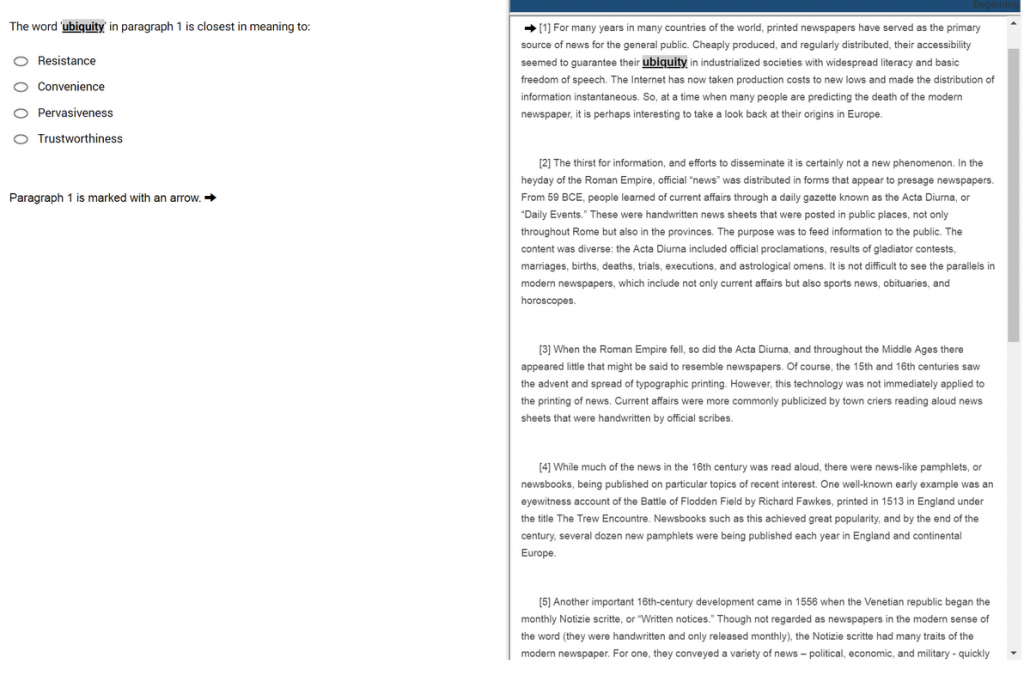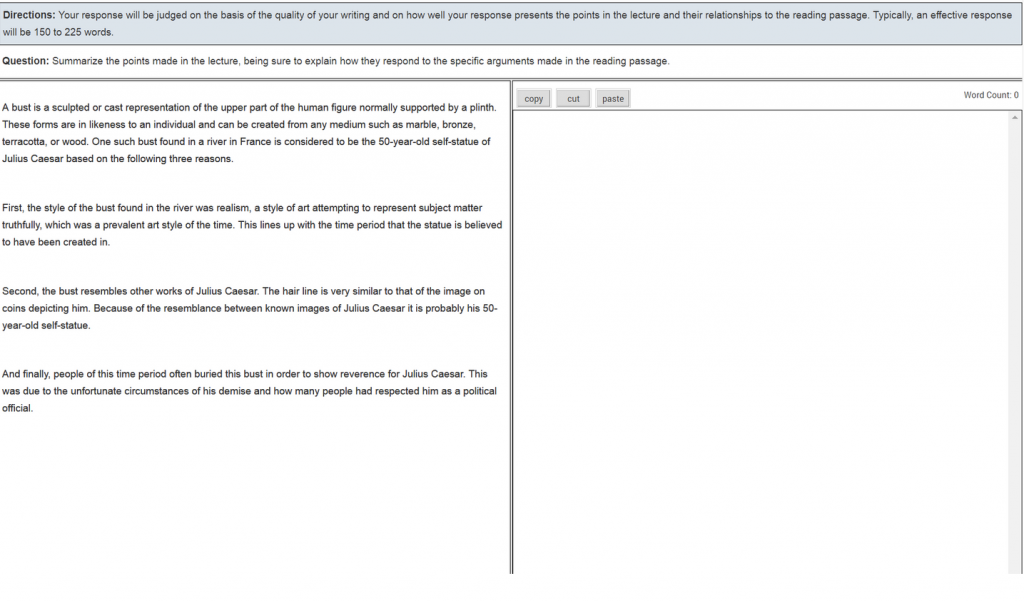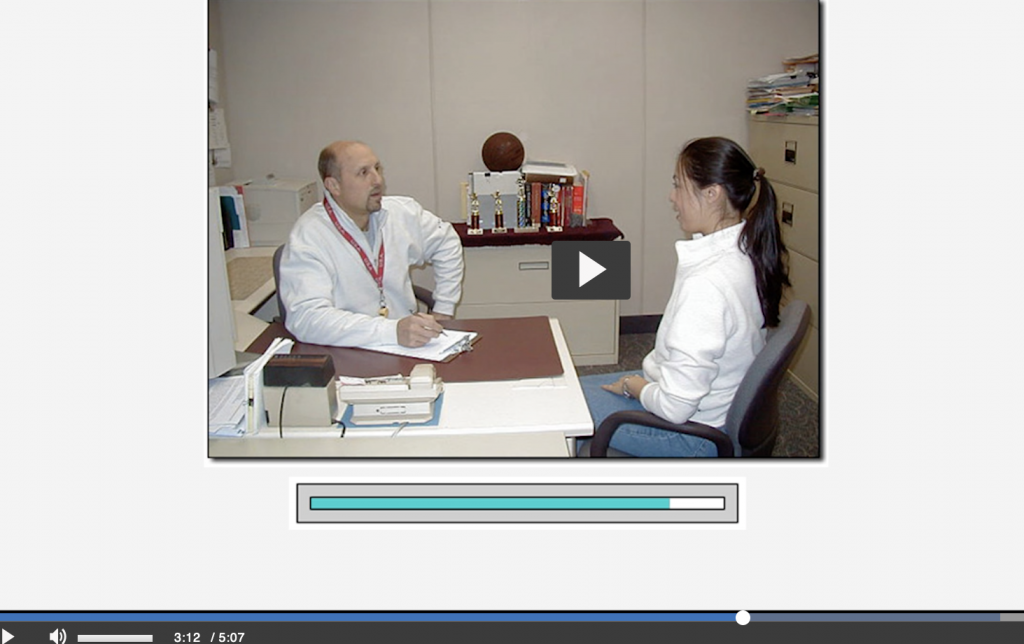The TOEFL® iBT is a test that measures a person’s ability to use and understand English in an academic environment. It is designed and provided by Educational Testing Service (ETS). The test measures all four language skills: reading, listening, speaking, and writing, and includes the following content:

- Academic texts with related questions
- Academic lectures with related questions
- Academic discussions with related questions
- Conversations between students with related questions
- Conversations between professors and students with related questions
- Opinion-based speaking and writing questions
The test is based on college-level academic material and common college situations. Notes are allowed on all sections of the test. The test can be taken at home or at a test center.
Contents
1. General Format of the TOEFL® iBT


2. How to Use the TOEFL® iBT
It is used by colleges at all levels to show a person can handle an educational program at their institutions. It is also sometimes used by companies to measure whether or not a person can handle English for one of their job openings. Also, in some situations, a specific score is required to qualify for a license to practice a job.
Different schools have different score requirements to qualify for their educational programs. Also, at the same school, different educational programs at different levels might have different requirements as well. These score requirements are always based on the total score but in some situations, there might also be an additional score requirement for a specific section of the test.
As a general guideline, here is a list of possible score requirements in relation to specific levels of education:

*Different licensing agencies and educational institutions have different score requirements.
Please contact the relevant organization to determine the exact requirements.
3. How to Take the TOEFL® iBT
The test can be taken at home or at a test center. The content of the test does not change based on how the test is taken.
To sign up for the test, visit the official ETS website. After creating an account, if choosing to take the test at a test center, select an available city from the website. It will show you a list of test centers in the area. After choosing a test center, it will show you a list of available test dates and times. After choosing a date and time, a confirmation email will be sent to you with relevant information including important test center rules and the documents or forms of identification that must be brought to the test center.

*The number of test centers and the number of available test dates and times differ based on the area.
4. Prices and Fees of the TOEFL® iBT
As of 2022, the registration fee to take the test is around 200 USD. However, this fee differs based on the location of the test center.
Also, if scheduling a test close to the test date, then there is a late registration fee of 40 USD which is added to the registration fee.
In addition to these fees, please keep the following fees in mind:
- Test Rescheduling Request (60 USD)
- Canceled Score Reinstatement Request (20 USD)
- Additional Score Report Request (20 USD per institution)
- Speaking Section Score Review (80 USD)
- Writing Section Score Review (80 USD)
5. Scoring Timeline of the TOEFL® iBT
Estimated scores on the reading and listening sections are provided as soon as the test is completed. These scores might differ from the final, official scores, and might be adjusted based on the difficulty of the test.
Scores on the speaking and writing sections are provided around 6 days after a test is completed. At that time, final scores on the reading and listening sections are also provided. When the scores are finalized and available for view, an email will be sent to you. After logging in to the ETS website, the scores from the test, as well as previous test results will be listed.
Within 2 days of the scores being available, it is possible to download them as a PDF copy from your ETS account. If choosing to do so, the test results can also be mailed to you and/or an educational institution.
Score reports include the scores on all four sections of the most recent test, the highest scores that a person has received on all four sections of the test (as long as they are within 2 years of the score report date), as well as a general description and level of English skill for each section of the test based on the score on each section as feedback.
6. Reading Section Overview
The reading section has 3 or 4 exercises. Each exercise has a passage of around 700 words and 10 questions.
It is possible to skip a question and return to it later.
If there are 3 exercises, then the time limit will be 54 minutes and all of the questions will affect the score.
If there are 4 exercises, then the time limit will be 72 minutes and the questions on 1 of the exercises will not affect your score. If this happens, then there will not be extra exercises on the listening section.
On the screen, the time limit will be shown at all times. One side of the screen has the passage. The other side of the screen has a question. This happens for all of the questions except for the final question on each passage. On the final question, the question will use the entire screen. By pressing a button on the screen, it is possible to view the passage again. By pressing a button on the screen, it is possible to view the final question again.

Sample TOEFL Reading test
All of the questions are worth 1 point towards the “raw score” except for the final question. The final question can be worth 2 to 3 points towards the “raw score.” The reading section tests the following skills:
FINDING INFORMATION
・The ability to skim a text quickly for important information
・The ability to understand words, phrases, and statements at a quick rate
LANGUAGE COMPREHENSION
・The ability to understand a general topic, main ideas, important points, specific facts and details,
vocabulary based on the situation, and pronoun identification.
・The ability to infer information based on what is in a passage.
LEARNING BY READING
・The ability to understand the organization or purpose of a passage.
・The ability to understand and infer the relationships between ideas in a passage.
・The ability to remember and recognize important points in a passage.
7. Listening Section Overview
The listening section has 5 or 7 exercises.
If there are 5 exercises, then there will be 2 conversations and 3 lectures and all of the questions will affect the score.
If there are 7 exercises, then there will be 3 conversations and 4 lectures and questions from 1 of the conversations and 1 of the lectures will not affect the score. If this happens, then there will not be extra exercises on the reading section.
Conversations are around 2 or 3 minutes. After a conversation, there will be 5 questions. Lectures are around 5 or 6 minutes. After a lecture, there will be 6 questions. After selecting an answer, it is not possible to return to a question and change the answer.
When doing questions, there is a time limit. This time limit is not related to the audio of the conversations or lectures. It is only related to answering the questions. The time limit is based on 11 questions, which are from 1 conversation and 1 lecture, or based on 17 questions, which are from 1 conversation and 2 lectures. If time runs out, then the test skips the remaining exercises and no points are given for the remaining questions.
The value of questions can be from 1 point to 3 points towards the “raw score”. As a general rule, to get points for a question, more than half of the correct answers must be selected. The listening section tests the following skills:
LANGUAGE COMPREHENSION
・The ability to understand the general idea, main points, and important details related to the main points of a
conversation or lecture
PURPOSE AND EMPHASIS
・The ability to recognize the attitude of a speaker and the level of certainty or emphasis related to information
given by a speaker
・The ability to recognize the purpose of a statement or how it is used by a speaker
CONNECTING AND RELATING INFORMATION
・The ability to understand the organization of information in a conversation or lecture
・The ability to understand and infer the relationships between ideas in a conversation or lecture
・The ability to infer information based on what is in a conversation or lecture
・The ability to recognize the introductions, conclusions, changes in topic, and situations that are unrelated to a topic
in a conversation or lecture
8. Speaking Section Overview
The speaking section has 4 exercises. Each question will have a time bar on the screen that shows either the preparation time or speaking time for each exercise. The speaking section tests the following skills:
IN AN ACADEMIC ENVIRONMENT
・The ability to respond to questions and express personal opinions
・The ability to participate in discussions with professors and students
・The ability to combine, connect, and summarize information from textbooks and lectures
IN A CAMPUS ENVIRONMENT
・The ability to participate in casual conversations and express personal opinions
・The ability to communicate with people in various campus situations, such as at the library, in a bookstore,
or other college facilities
A question is shown on the screen and read by a narrator. The response to the question will be based on personal opinion and must include an answer, reasons, and examples. After the question is provided, the preparation time is 15 seconds, and the speaking time is 45 seconds.
A paragraph of information (80 – 110 words) is shown on the screen. The paragraph describes a change, a possible change, or a suggested change related to a college. The paragraph is on the screen for 45 or 50 seconds, and it cannot be read again.
After this, there is a conversation (60 – 80 seconds) between two students about the change in the reading.
The conversation is played one time. One of these students has a strong opinion about the change and gives two reasons to support his or her opinion. A question is then shown on the screen and read by a narrator. To answer the question, a response must have a short summary of the reading and explain the opinion and reasons of the more important person from the conversation. After the question is provided, the preparation time is 30 seconds, and the speaking time is 60 seconds.
A paragraph of information (80 – 110 words) is shown on the screen. The paragraph is a general description of an idea or concept. The paragraph is on the screen for 45 or 50 seconds, and it cannot be read again. After this, there is a lecture (60 – 90 seconds) that gives specific information related to the topic of the reading. The lecture is played one time. A question is then shown on the screen and read by a narrator.
To answer the question, a response must have a short summary of the reading and a balanced, accurate description of the information in the lecture. After the question is provided, the preparation time is 30 seconds, and the speaking time is 60 seconds.
There is a lecture (90 – 120 seconds) that gives a short introduction to an idea or concept. Then, it has specific information related to the topic. The lecture is played one time. A question is then shown on the screen and read by a narrator.
To answer the question, a response must have a balanced, accurate summary of the information in the lecture. After the question is provided, the preparation time is 20 seconds, and the speaking time is 60 seconds.
9. Writing Section Overview
The writing section has 2 exercises. Time limits are shown on the screen at all times. There is no spell check or grammar check feature, and it is possible to cut and paste written information but it is not possible to copy and paste information in the written responses. The number of words is also shown on the screen while writing. The writing section tests the following skills:
ON WRITING 1 (INTEGRATED)
・The ability to take notes on written and spoken sources of information in a detailed and organized way
・The ability to summarize, paraphrase, and make reference to information from written and spoken sources of information
・The ability to describe and explain the connections and relationships between written and spoken sources of information
ON WRITING 2 (INDEPENDENT)
・The ability to express a main idea and provide important points to support it
・The ability to plan and organize an essay based on personal opinions
・The ability to describe past events, personal experiences, and current situations to support an opinion
・The ability to develop an idea by using reasons, examples, and details
・The ability to connect ideas by using transitional phrases and linking words
・The ability to organize, connect, and explain ideas in a way that is easy to understand
・The ability to use various forms of grammar and vocabulary in correct and appropriate ways
・The ability to spell words, use punctuation, and format writing in the correct ways
Sample TOEFL Writing Test
A passage is shown on the screen. It has 4 paragraphs. The time limit to read is 3 minutes. When writing, the passage will be shown on the screen again. After this, there will be a lecture. The lecture will oppose all of the theories or reasons that are in the passage. The lecture is played one time. A question is then shown on the screen and read by a narrator.
To answer the question, the response must give a short summary of the reading and an accurate, developed description of the information in the lecture. After the question is provided, the writing time is 20 minutes. The suggested size of the writing is 150 to 225 words.
A question is shown on the screen. The response to the question will be based on personal opinion and must include an answer, reasons, and examples. After the question is provided, the writing time is 30 minutes. The suggested size of the writing is more than 300 words.
Resources:
ETS TOEFL website
TOEFL TV Official
Kyle Hanano has been an English teacher since 2005. He has experience teaching students of all ages and skill levels. However, he has the most teaching experience in test preparation, especially in regards to the TOEFL examination. He has been a part of Mentor Language Institute since 2008. Prior to that, he was an assistant language teacher in Japan with the JET Programme for three years. He holds a B.A. in English Literature and a B.A. in Japanese Language and Culture from the University of California at Los Angeles, and he graduated in 2005.










